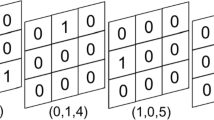Abstract
We develop a new one-to-one correspondence between a two-dimensional (m × n, k, ρ) optical orthogonal code (2-D (m × n, k, ρ)-OOC) with AM-OPPTS (at most one-pulse per time slot) property and a certain combinatorial subject, called an n-cyclic holey packing of type m n. By this link, an upper bound on the size of a 2-D (m × n, k, ρ)-OOC with AM-OPPTS property is derived. Afterwards, we employ combinatorial methods to construct infinitely many 2-D (m × n, k, 1)-OOCs with AM-OPPTS property, whose existence was previously unknown. All these constructions meet the upper bounds with equality and are thus optimal.
Similar content being viewed by others
References
Abel R.J.R., Buratti M.: Some progress on (v, 4, 1) difference families and optical orthogonal codes. J. Comb. Theory A 106, 59–75 (2004)
Alderson T.L., Mellinger K.E.: 2-Dimensional optical orthogonal codes from singer groups. Discret. Appl. Math. 157, 3008–3019 (2009)
Bose R.C.: On the construction of balanced incomplete block designs. Ann. Engenics 9, 353–399 (1939)
Brickell E.F., Wei V.K.: Optical orthogonal codes and cyclic block designs. Congr. Numer. 58, 175–192 (1987)
Brouwer A.E., Schrijver A., Hanani H.: Group divisible designs with block-size four. Discret. Math. 20, 1–10 (1977)
Cao H., Wei R., Su Y.: Combinatorial constructions for optimal optical two-dimensional orthogonal codes. IEEE Trans. Inf. Theory 55, 1387–1394 (2009)
Chung F.R.K., Salehi J.A., Wei V.K.: Optimal optical orthogonal codes: design, analysis, and applications. IEEE Trans. Inf. Theory 35, 595–604 (1989)
Colbourn M.J., Colbourn C.J.: On cyclic block designs. Math. Rep. Can. Acad. Sci. 2, 95–98 (1980)
Colbourn C.J., Dinitz J.H., Stinson D.R.: Applications of combinatorial designs to communications, cryptography, and networking. Lond. Math. Soc. Lect. Notes Ser. 267, 37–100 (1999)
Colbourn, C.J., Dinitz, J.H. (eds): CRC Handbook of Combinatorial Designs, 2nd edn. Chapman and Hall/CRC, Boca Raton (2007)
Ge G., Yin J.: Constructions for optimal (v, 4, 1) optical orthogonal codes. IEEE Trans. Inf. Theory 47, 2998–3004 (2001)
Gronau H.-D.O.F., Mullin R.C., Pietsch C.: The closure of all subsets of {3, 4, . . . , 10} which include 3. Ars Comb. 41, 129–161 (1995)
Hanani H.: Balanced incomplete block designs and related designs. Discret. Math. 11, 255–369 (1975)
Huang Y., Chang Y.: Two classes of optimal two-dimensional OOCs. Des. Codes Cryptogr. 63, 357–363 (2012)
Johnson S.M.: A new upper bound for error-correcting codes. IEEE Trans. Inf. Theory 8, 203–207 (1962)
Kwong W.C., Yang G.C.: Extended carrier-hopping prime codes for wavelength-time optical code-division multiple access. IEEE Trans. Commun. 52, 1084–1091 (2004)
Kwong W.C., Yang G.C., Baby V., Bres C.S., Prucnal P.R.: Multiple-wavelength optical orthogonal codes under prime-sequence permutations for optical CDMA. IEEE Trans. Commun. 53, 117–123 (2005)
Ma S., Chang Y.: Constructions of optimal optical orthogonal codes with weight five. J. Comb. Des. 13, 54–69 (2005)
Mendez A.J., Gagliardi R.M., Hernandez V.J., Bennett C.V., Lennon W.J.: Design and performance analysis of wavelength/time (W/T) matrix codes for optical CDMA. J. Lightwave Technol. 21, 2524–2533 (2003)
Mills W.H.: On the existence of H designs. Congr. Numer. 79, 129–141 (1990)
Mohácsy H., Ray-Chaudhuri D.K.: Candelabra systems and designs. J. Stat. Plan. Inferences 106, 419–448 (2002)
Omrani R., Kummar P.V.: Codes for optical CDMA. Proceedings of SETA 2006(Springer Lect. Notes Comput. Sci. Ser. 4086), 34–46 (2006)
Omrani R., Garg G., Kumar P.V., Elia P., Bhambhani P.: Large families of optimal two-dimensional optical orthogonal codes. arXiv:0911.0143v1 [cs.IT] (November 2009).
Peltesohn R.: Eine Losung der beiden Heffterschen Differenzenprobleme. Comput. Math. 6, 251–257 (1939)
Salehi J.A., Brackett C.A.: Code-division multiple access techniques in optical fiber networks: part 1 and part 2. IEEE Trans. Commun. 37, 824–842 (1989)
Shivaleea E.S., Sivarajan K.N., Selvarajan A.: Design of a new family of two-dimensional codes for fiber-optic CDMA networks. J. Lightwave Technol. 16, 501–508 (1998)
Shivaleea E.S., Selvarajan A., Srinivas T.: Two-dimensional optical orthogonal codes for fiber-optic CDMA networks. J. Lightwave Technol. 23, 647–654 (2005)
Shurong S., Yin H., Wang Z., Xu A.: A new family of 2-D optical orthogonal codes and analysis of its performance in optical CDMA access networks. J. Lightwave Technol. 24, 1646–1653 (2006)
Vecchi M.P., Salehi J.A.: Neuromorphic networks based on sparse optical orthogonal codes. In: Neural Information Processing Systems—Natural and Synthetic, pp. 814–823. American Institute of Physics, New York (1988).
Wang K., Wang J.: Semicyclic 4-GDDs and related two-dimensional optical orthogonal codes. Des. Codes Cryptogr. 63, 305–319 (2012)
Wang J., Yin J.: Two-dimensional optical orthogonal codes and semi-cyclic group divisible designs. IEEE Trans. Inf. Theory 56, 2177–2187 (2010)
Wang J., Shan X., Yin J.: On constructions for optimal two-dimensional optical orthogonal codes. Des. Codes Cryptogr. 54, 43–60 (2010)
Wilson R.M.: Cyclotomy and difference families in elementary abelian groups. J. Number Theory 4, 17–47 (1972)
Yang G.C., Kwong W.C.: Performance comparison of multiwavelength CDMA and WDMA + CDMA for fiber-optic networks. IEEE Trans. Commun. 45, 1426–1434 (1997)
Yim R.M.H., Chen L.R., Bajcsy J.: Design and performance of 2-D codes for wavelength-time optical CDMA. IEEE Photonics Technol. Lett. 14, 714–716 (2002)
Yin J.: Some combinatorial constructions for optical orthogonal codes. Discret. Math. 185, 201–219 (1998)
Yin J.: Packing designs with equal-sized holes. J. Stat. Plan. Inferences 94, 393–403 (2001)
Author information
Authors and Affiliations
Corresponding author
Additional information
Communicated by C. Mitchell.
Rights and permissions
About this article
Cite this article
Dai, P., Wang, J. & Yin, J. Combinatorial constructions for optimal 2-D optical orthogonal codes with AM-OPPTS property. Des. Codes Cryptogr. 71, 315–330 (2014). https://doi.org/10.1007/s10623-012-9733-z
Received:
Revised:
Accepted:
Published:
Issue Date:
DOI: https://doi.org/10.1007/s10623-012-9733-z



